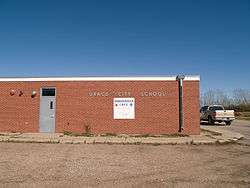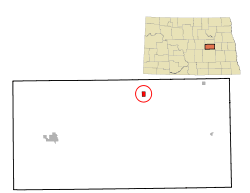Grace City, North Dakota
Grace City is a city in Foster County, North Dakota, United States. The population was 63 at the 2010 census.[5] Grace City was founded in 1910.
Grace City, North Dakota | |
|---|---|
 Grace City School | |
 Location of Grace City, North Dakota | |
| Coordinates: 47°33′2″N 98°48′16″W | |
| Country | United States |
| State | North Dakota |
| County | Foster |
| Area | |
| • Total | 0.24 sq mi (0.63 km2) |
| • Land | 0.24 sq mi (0.63 km2) |
| • Water | 0.00 sq mi (0.00 km2) |
| Elevation | 1,512 ft (461 m) |
| Population | |
| • Total | 63 |
| • Estimate (2019)[3] | 58 |
| • Density | 236.73/sq mi (91.54/km2) |
| Time zone | UTC-6 (Central (CST)) |
| • Summer (DST) | UTC-5 (CDT) |
| ZIP code | 58445 |
| Area code(s) | 701 |
| FIPS code | 38-31740 |
| GNIS feature ID | 1029191[4] |
Geography
Grace City is located at 47°33′02″N 98°48′16″W.[6]
According to the United States Census Bureau, the city has a total area of 0.40 square miles (1.04 km2), all of it land.[7]
Demographics
| Historical population | |||
|---|---|---|---|
| Census | Pop. | %± | |
| 1990 | 108 | — | |
| 2000 | 71 | −34.3% | |
| 2010 | 63 | −11.3% | |
| Est. 2019 | 58 | [3] | −7.9% |
| U.S. Decennial Census[8] 2018 Estimate[9] | |||
2010 census
As of the census[2] of 2010, there were 63 people, 30 households, and 17 families residing in the city. The population density was 157.5 inhabitants per square mile (60.8/km2). There were 36 housing units at an average density of 90.0 per square mile (34.7/km2). The racial makeup of the city was 98.4% White and 1.6% Native American.
There were 30 households, of which 30.0% had children under the age of 18 living with them, 36.7% were married couples living together, 16.7% had a female householder with no husband present, 3.3% had a male householder with no wife present, and 43.3% were non-families. 36.7% of all households were made up of individuals, and 10% had someone living alone who was 65 years of age or older. The average household size was 2.10 and the average family size was 2.82.
The median age in the city was 36.5 years. 27% of residents were under the age of 18; 6.3% were between the ages of 18 and 24; 20.6% were from 25 to 44; 31.7% were from 45 to 64; and 14.3% were 65 years of age or older. The gender makeup of the city was 57.1% male and 42.9% female.
2000 census
As of the census of 2000, there were 71 people, 30 households, and 17 families residing in the city. The population density was 176.4 people per square mile (68.5/km2). There were 39 housing units at an average density of 96.9 per square mile (37.6/km2). The racial makeup of the city was 100.00% White. Hispanic or Latino of any race were 1.41% of the population.
There were 30 households, out of which 30.0% had children under the age of 18 living with them, 46.7% were married couples living together, 6.7% had a female householder with no husband present, and 43.3% were non-families. 36.7% of all households were made up of individuals, and 20.0% had someone living alone who was 65 years of age or older. The average household size was 2.37 and the average family size was 3.29.
In the city, the population was spread out, with 29.6% under the age of 18, 9.9% from 18 to 24, 26.8% from 25 to 44, 23.9% from 45 to 64, and 9.9% who were 65 years of age or older. The median age was 37 years. For every 100 females, there were 86.8 males. For every 100 females age 18 and over, there were 85.2 males.
The median income for a household in the city was $33,333, and the median income for a family was $43,750. Males had a median income of $32,321 versus $20,000 for females. The per capita income for the city was $14,789. There were 15.8% of families and 18.2% of the population living below the poverty line, including 17.1% of under eighteens and 100.0% of those over 64.
References
- "2019 U.S. Gazetteer Files". United States Census Bureau. Retrieved July 27, 2020.
- "U.S. Census website". United States Census Bureau. Retrieved June 14, 2012.
- "Population and Housing Unit Estimates". United States Census Bureau. May 24, 2020. Retrieved May 27, 2020.
- "US Board on Geographic Names". United States Geological Survey. October 25, 2007. Retrieved January 31, 2008.
- "2010 Census Redistricting Data (Public Law 94-171) Summary File". American FactFinder. United States Census Bureau. Retrieved May 2, 2011.
- "US Gazetteer files: 2010, 2000, and 1990". United States Census Bureau. February 12, 2011. Retrieved April 23, 2011.
- "US Gazetteer files 2010". United States Census Bureau. Archived from the original on January 25, 2012. Retrieved June 14, 2012.
- United States Census Bureau. "Census of Population and Housing". Retrieved February 12, 2014.
- "Population Estimates". United States Census Bureau. Retrieved September 8, 2019.
